Long Term Monitoring and Connection between Topography and Cloud Cover Distribution in Serbia
Abstract
1. Introduction
2. Materials and Methods
2.1. Data
2.2. GIS and Remote Sensing Analysis
2.3. Statistical Analysis of Mann–Kendall Test
Geostatistical Analysis
3. Results and Discussion
3.1. Absolute Cloudiness in the Last Thirty Years
3.2. The Analysis of Linear Trend and Mann–Kendall Test
4. Conclusions
Author Contributions
Funding
Institutional Review Board Statement
Informed Consent Statement
Data Availability Statement
Acknowledgments
Conflicts of Interest
References
- Renaud, V.; Rebetez, M. Comparison between open-site and below-canopy climatic conditions in Switzerland during the exceptionally hot summer of 2003. Agric. For. Meteorol. 2009, 149, 873–880. [Google Scholar] [CrossRef]
- Oriani, F.; Ohana-Levi, N.; Marra, F.; Straubhaar, J.; Mariethoz, G.; Renard, P.; Karnieli, A.; Morin, E. Simulating small-scale rainfall fields conditioned by weather state and elevation: A data-driven approach based on rainfall radar images. Water. Resour. 2017, 53, 8512–8532. [Google Scholar] [CrossRef]
- Mazgareanua, P.; Biron, P.M.; Buffin-Bélangerb, T. A fuzzy GIS model to determine confluence morphological sensitivity to tributary inputs at the watershed scale. Geomorphology 2020, 357, 107095. [Google Scholar] [CrossRef]
- Srivastava, A.; Saco, P.M.; Rodriguez, J.F.; Kumari, N.; Chun, K.P.; Yetemen, O. The role of landscapemorphology on soil moisture variability in semi-aridecosystems. Hydrol. Process. 2021, 35, e13990. [Google Scholar] [CrossRef]
- Kumari, N.; Saco, P.M.; Rodriguez, J.F.; Johnstone, S.A.; Srivastava, A.; Chun, K.P.; Yetemen, O. The grass is not always greener on the other side: Seasonal reversal of vegetation greenness in aspect-driven semiarid ecosystems. Geophys. Res. Lett. 2020, 47, e2020GL088918. [Google Scholar] [CrossRef]
- Wilson, A.M.; Jetz, W. Remotely Sensed High-Resolution Global Cloud Dynamics for Predicting Ecosystem and Biodiversity Distributions. PLoS Biol. 2016, 14, e1002415. [Google Scholar] [CrossRef]
- Goldsmith, G.R.; Matzke, N.J.; Dawson, T.E. The incidence and implications of clouds for cloud forest plant water relations. Ecol. Lett. 2013, 16, 307–314. [Google Scholar] [CrossRef]
- Graham, E.A.; Mulkey, S.S.; Kitajima, K.; Phillips, N.G.; Wright, S.J. Cloud cover limits net CO2 uptake and growth of a rainforest tree during tropical rainy seasons. Proc. Nat. Acad. Sci. USA 2003, 100, 572–576. [Google Scholar] [CrossRef]
- Warren, S.G.; Hahn, C.J.; London, J.; Chervin, R.M.; Jenne, R.L. Global Distribution of Total Cloud Cover and Cloud Type Amounts Over Land (No. NCAR/TN-273+STR); University Corporation for Atmospheric Research: Boulder, CO, USA, 1986. [Google Scholar] [CrossRef]
- Barrett, E.C.; Grant, C.K. Relations Between Frequency Distributions of Cloud over the United Kingdom based on Conventional observations and imagery from Landsat 2. Weather 1979, 34, 416–424. [Google Scholar] [CrossRef]
- Dörnbrack, A.; Kaifler, B.; Kaifler, N.; Rapp, M.; Wildmann, N.; Garhammer, M.; Ohlmann, K.; Payne, J.M.; Sandercock, M.; Austin, E.J. Unusual appearance of mother-of-pearl clouds above El Calafate, Argentina (50°21′S, 72°16′W). Weather 2020, 75, 378–388. [Google Scholar] [CrossRef]
- Burić, D.; Stanojević, G. Trends and possible causes of cloudiness variabilit in Montenegro in the period 1961−2017. Clim. Res. 2020, 81, 187–205. [Google Scholar] [CrossRef]
- Wylie, D.; Jackson, D.L.; Menzel, W.P.; Bates, J.J. Trends in Global Cloud Cover in Two Decades of HIRS Observations. J. Clim. 2005, 18, 3021–3031. [Google Scholar] [CrossRef]
- Norris, J.R. What Can Cloud Observations Tell Us About Climate Variability? Space Sci. Rev. 2000, 94, 375–380. [Google Scholar] [CrossRef]
- Clement, A.C.; Burgman, R.; Norris, J.R. Observational and model evidence for positive low-level cloud feedback. Science 2009, 325, 460–464. [Google Scholar] [CrossRef]
- Tošić, I.; Hrnjak, I.; Gavrilov, M.B.; Unkašević, M.; Marković, S.B.; Lukić, T. Annual and seasonal variability of precipitation in Vojvodina, Serbia. Theor. Appl. Climatol. 2014, 117, 331–341. [Google Scholar] [CrossRef]
- Unkašević, M.; Radinović, Đ. 2000: Statistical analysis of daily maximum and monthly precipitation at Belgrade. Theor. Appl. Climatol. 2000, 66, 241–249. [Google Scholar] [CrossRef]
- Tošić, I.; Unkašević, M. Analysis of precipitation series for Belgrade. Theor. Appl. Climatol. 2005, 80, 67–77. [Google Scholar] [CrossRef]
- Hrnjak, I.; Lukić, T.; Gavrilov, M.B.; Marković, S.B.; Unkašević, M.; Tošić, I. Aridity in Vojvodina, Serbia. Theor. Appl. Climatol. 2014, 115, 323–332. [Google Scholar] [CrossRef]
- Bačević, N.; Vukoičić, D.; Nikolić, M.; Janc, N.; Milentijević, N.; Gavrilov, M.B. Aridity in Kosovo and Metohija, Serbia. Carpathian J. Earth. Environ. Sci. 2017, 12, 563–570. [Google Scholar]
- Rosenfeld, D.; Woodley, W.L. Effects of Cloud Seeding in West Texas. J. Appl. Meteorol. Climatol. 1989, 28, 1050–1080. [Google Scholar] [CrossRef]
- Dennis, A.S. Weather Modification by Cloud Seeding. Int. Geophys. Ser. Rep. Pap. 1980, 24, 670. [Google Scholar]
- Givati, A.; Rosenfeld, D. Separation between Cloud-Seeding and Air-Pollution Effects. J. Appl. Meteorol. 2005, 44, 1298–1314. [Google Scholar] [CrossRef]
- Sfîcă, L.; Beck, C.; Nita, A.I.; Voiculescu, M.; Birsan, M.V.; Philipp, A. Cloud cover changes driven by atmospheric circulation in Europe during the last decades. Int. J. Climatol. 2020, 1–20. [Google Scholar] [CrossRef]
- Krichak, S.; Alpert, P. Signatures of the NAO in the atmospheric circulation during wet winter months over the Mediterranean region. Theor. Appl. Climato. 2005, 82, 27–39. [Google Scholar] [CrossRef]
- Efthymiadis, D.; Goodness, C.M.; Jones, P.D. Trends in Mediterranean gridded temperature extremes and large−scale circulation influences. Nat. Hazards Earth. Syst. Sci. 2011, 11, 2199–2214. [Google Scholar] [CrossRef]
- West, H.; Quinn, N.; Horswell, M. Spatio-Temporal Variability in North Atlantic Oscillation Monthly Rainfall Signatures in Great Britain. Atmosphere 2021, 12, 763. [Google Scholar] [CrossRef]
- Pyrina, M.; Moreno-Chamarro, E.; Wagner, S.; Zorita, E. Surface and Tropospheric Response of North Atlantic Summer Climate from Paleoclimate Simulations of the Past Millennium. Atmosphere 2021, 12, 568. [Google Scholar] [CrossRef]
- Ebert, K.C.; Hättestranda, C.; Hall, A.M.; Alm, G. DEM identification of macroscale stepped relief in arctic northern Sweden. Geomorphology 2011, 132, 339–350. [Google Scholar] [CrossRef]
- Hayakawa, Y.S.; Oguchi, T. GIS analysis of fluvial knickzone distribution in Japanese mountain watersheds. Geomorphology 2009, 111, 27–37. [Google Scholar] [CrossRef]
- Hoffmann, H.E.; Roth, R. Cloudphysical parameters in dependence on height above cloud base in different clouds. Meteorol. Atmos. Phys. 1989, 41, 247–254. [Google Scholar] [CrossRef][Green Version]
- Vogelgesang, R. Radiation transfer in finite cylindrical clouds. Meteorol. Atmos. Phys. 1996, 58, 205–214. [Google Scholar] [CrossRef]
- Petitcolin, F.; Vermote, E. Land surface reflectance, emissivity and temperature from MODIS middle and thermal infrared data. Remote Sens. Environ. 2002, 83, 112–134. [Google Scholar] [CrossRef]
- Roger, J.C.; Vermote, E.F. A Method to Retrieve the Reflectivity Signature at 3.75 μm from AVHRR Data. Remote Sens. Environ. 1998, 64, 103–114. [Google Scholar] [CrossRef]
- Schneider, A.; Friedl, M.A.; Potere, D. A new map of global urban extent from MODIS satellite data. Environ. Res. Lett. 2009, 4, 044003. [Google Scholar] [CrossRef]
- Nee, J.B.; Lu, C.Y. Seasonal migration of cirrus clouds by using CALIOP observations. Meteorol. Atmos. Phys. 2021, 133, 579–587. [Google Scholar] [CrossRef]
- Ponomarev, E.; Yakimov, N.; Ponomareva, T.; Yakubailik, O.; Conard, S.G. Current Trend of Carbon Emissions from Wildfires in Siberia. Atmosphere 2021, 12, 559. [Google Scholar] [CrossRef]
- Heidinger, A.K.; Evan, A.T.; Foster, M.J.; Walther, A. A naive Bayesian cloud-detection scheme derived from CALIPSO and applied within PATMOS-x. J. Appl. Meteorol. Climatol. 2012, 51, 1129–1144. [Google Scholar] [CrossRef]
- Valjarević, A.; Djekić, T.; Stevanović, V.; Ivanović, R.; Jandziković, B. GIS numerical and remote sensing analyses of forest changes in the Toplica region for the period of 1953–2013. Appl. Geogr. 2018, 92, 131–139. [Google Scholar] [CrossRef]
- Ceppi, P.; Nowack, P. Observational evidence that cloud feedback amplifies global warming. Proc. Natl. Acad. Sci. USA 2021, 118, e2026290118. [Google Scholar] [CrossRef] [PubMed]
- Yao, B.; Teng, S.; Lai, R.; Xu, X.; Yin, Y.; Shi, C.; Liu, C. Can atmospheric reanalyses (CRA and ERA5) represent cloud spatiotemporal characteristics? Atmos. Res. 2020, 244, 105091. [Google Scholar] [CrossRef]
- Dee, D.P.; Uppala, S.M.; Simmons, A.J.; Berrisford, P.; Poli, P.; Kobayashi, S.; Andrae, U.; Balmaseda, M.A.; Balsamo, G.; Bauer, P.; et al. The ERA-Interim reanalysis: Configuration and performance of the data assimilation system. Q. J. R. Meteorol. Soc. 2011, 137, 553–597. [Google Scholar] [CrossRef]
- Thornton, M.W.; Atkinson, P.M.; Holland, D.A. A linearised pixel-swapping method for mapping rural linear land cover features from fine spatial resolution remotely sensed imagery. Comput. Geosci. 2007, 33, 1261–1272. [Google Scholar] [CrossRef]
- Liu, R.; Liu, Y. Generation of new cloud masks from MODIS land surface reflectance products. Remote Sens. Environ. 2013, 133, 21–37. [Google Scholar] [CrossRef]
- Wilson, A.M.; Silander, J.A. Estimating uncertainty in daily weather interpolations: A Bayesian framework for developing climate surfaces. Int. J. Climatol. 2014, 34, 2573–2584. [Google Scholar] [CrossRef]
- Lukić, T.; Marić, P.; Hrnjak, I.; Gavrilov, M.B.; Mladjan, D.; Zorn, M.; Komac, B.; Milošević, Z.; Marković, S.B.; Sakulski, D.; et al. Forest fire analysis and classification based on a Serbian case study. Acta. Geogr. Slov. 2017, 57, 51–63. [Google Scholar] [CrossRef]
- Jawak, S.D.J.; Luis, A.J. Improved land cover mapping using high resolution multiangle 8-band WorldView-2 satellite remote sensing data. Appl. Remote Sens. 2013, 7, 073573. [Google Scholar] [CrossRef]
- Li, T.; Fu, B.; Ge, X.; Wang, B.; Peng, M. Satellite data analysis and numerical simulation of tropical cyclone formation. Geophys. Res. Lett. 2003, 30, 2122. [Google Scholar] [CrossRef]
- Lu, L.; Shen, X.; Cao, R. Elevational Movement of Vegetation Greenness on the Tibetan Plateau: Evidence from the Landsat Satellite Observations during the Last Three Decades. Atmosphere 2021, 12, 161. [Google Scholar] [CrossRef]
- Gorelick, N.; Hancher, M.; Dixon, M.; Ilyushchenko, S.; Thau, D.; Moore, R. Google Earth Engine: Planetary-scale geospatial analysis for everyone. Remote Sens. Environ. 2017, 202, 18–27. [Google Scholar] [CrossRef]
- Liu, C.; Yang, S.; Di, D.; Yang, Y.; Zhou, C.; Hu, X.; Sohn, B. A Machine Learning-based Cloud Detection Algorithm for the Himawari-8 Spectral Image. Adv. Atmos. Sci. 2021. [Google Scholar] [CrossRef]
- Letu, H.; Yang, K.; Nakajima, T.Y.; Ishimoto, H.; Nagao, T.M.; Riedi, J.; Baran, A.J.; Ma, R.; Wang, T.; Shang, H.; et al. High-resolution retrieval of cloud microphysical properties and surface solar radiation using Himawari-8/AHI next-generation geostationary satellite. Remote Sens. Environ. 2020, 239, 111583. [Google Scholar] [CrossRef]
- Srivastava, A.; Rodriguez, J.F.; Saco, P.M.; Kumari, N.; Yetemen, O. Global Analysis of Atmospheric Transmissivity Using Cloud Cover, Aridity and Flux Network Datasets. Remote Sens. 2021, 13, 1716. [Google Scholar] [CrossRef]
- Tomazos, K.; Butler, R. Volunteer tourism: The new ecotourism? Anatolia Int. J. Tour. Res. 2009, 20, 196–211. [Google Scholar] [CrossRef]
- Valjarević, A.; Filipović, D.; Valjarević, D.; Milanović, M.; Milošević, S.; Živić, N.; Lukić, T. GIS and remote sensing techniques for the estimation of dew volume in the Republic of Serbia. Meteorol. Appl. 2020, 27, e1930. [Google Scholar] [CrossRef]
- Flantua, S.G.A.; van Boxel, J.H.; Hooghiemstra, H.; van Smaalen, J. Application of GIS and logistic regression to fossil pollen data in modelling present and past spatial distribution of the Colombian savanna. Clim. Dyn. 2007, 29, 697–712. [Google Scholar] [CrossRef]
- Ivanov, V.Y.; Vivoni, E.R.; Bras, R.L.; Entekhabi, D. Catchment hydrologic response with a fully distributed triangulated irregular network model. Water Resour. Res. 2004, 40, W11102. [Google Scholar] [CrossRef]
- Wu, J.; Amaratunga, K. Wavelet triangulated irregular networks. Int. J. Geogr. Inf. Sci. 2003, 17, 273–289. [Google Scholar] [CrossRef]
- Yang, B.; Li, Q.; Shi, W. Constructing multi-resolution triangulated irregular network model for visualization. Comput. Geosci. 2005, 31, 77–86. [Google Scholar] [CrossRef]
- Berg, N.; Hori, T.; Take, W.A. Calculation of 3D displacement and time to failure of an earth dam using DIC analysis of hillshade images derived from high temporal resolution point cloud data. Landslides 2020, 17, 499–515. [Google Scholar] [CrossRef]
- Barbier, N.; Proisy, C.; Véga, C.; Sabatier, D.; Couteron, P. Bidirectional texture function of high resolution optical images of tropical forest: An approach using LiDAR hillshade simulations. Remote Sens. Environ. 2011, 115, 167–179. [Google Scholar] [CrossRef]
- O’Driscoll, J. Landscape applications of photogrammetry using unmanned aerial vehicles. J. Archaeol. Sci. Rep. 2018, 22, 32–44. [Google Scholar] [CrossRef]
- Brewer, J.; Ames, D.P.; Solan, D.; Lee, R.; Carlisle, J. Using GIS analytics and social preference data to evaluate utility-scale solar power site suitability. Renew. Energy 2015, 81, 825–836. [Google Scholar] [CrossRef]
- Mann, H.B. Non-parametric tests against trend. Econometrica 1945, 13, 245–259. [Google Scholar] [CrossRef]
- Kendall, M. A new measure of rank correlation. Biometrika 1938, 30, 81–89. [Google Scholar] [CrossRef]
- Gilbert, R.O. Statistical Methods for Environmental Pollution Monitoring; Wiley: New York, NY, USA, 1987. [Google Scholar]
- Karmeshu, N. Trend Detection in Annual Temperature and Precipitation using the Mann Kendall Test—A Case Study to Assess Climate Change on Select States in the Northeastern United States. Master’s Thesis, University of Pennsylvania, Philadelphia, PA, USA, 2012. [Google Scholar]
- Razavi, T.; Switzman, H.; Arain, A.; Coulibaly, P. Regional climate change trends and uncertainty analysis using extreme indices: A case study of Hamilton, Canada. Clim. Risk Manag. 2016, 13, 43–63. [Google Scholar] [CrossRef]
- Gavrilov, M.B.; Marković, S.B.; Janc, N.; Nikolić, M.; Valjarević, A.; Komac, B.; Zorn, M.; Punišić, M.; Bačević, N. Assessing average annual air temperature trends using the Mann-Kendall test in Kosovo. Acta Geogr. Slov. 2018, 58, 8–25. [Google Scholar] [CrossRef]












| Clou. in km2. | Jan. | Feb. | Mar. | Apr. | May | Jun. | Jul. | Aug. | Sep. | Oct. | Nov. | Dec. |
|---|---|---|---|---|---|---|---|---|---|---|---|---|
| <8 | 77,998 | 47,557.1 | 84,259.6 | 84,479.7 | 84,593.8 | 86,844.6 | 87,266.4 | 85,509.2 | 85,266.1 | 81,942 | 74,028.8 | 82,663.7 |
| 8–12 | 6872 | 34,452.2 | 1990 | 2024 | 2245 | 711 | 483 | 1899 | 2334 | 4001 | 9319 | 2885 |
| 12–16 | 102 | 4110 | 1116 | 899 | 917 | 272 | 340 | 735 | 200 | 1339 | 2427 | 988 |
| 16–20 | 1984 | 323 | 290 | 302 | 146 | 328 | 123 | 74.9 | 134 | 242 | 234 | 184 |
| 20–24 | 838 | 568 | 297 | 301 | 203 | 124 | 93.5 | 21.1 | 170 | 508 | 1318 | 523 |
| >24 | 567 | 1350 | 408 | 356 | 257 | 81.9 | 55.1 | 123 | 257 | 330 | 1034 | 1117 |
| Total | 88,361 | 88,361 | 88,361 | 88,361 | 88,361 | 88,361 | 88,361 | 88,361 | 88,361 | 88,361 | 88,361 | 88,361 |
| MIN | 102 | 323 | 290 | 301 | 146 | 81.9 | 55.1 | 21.1 | 82.7 | 242 | 234 | 184 |
| MAX | 77,998 | 47,557.1 | 84,259.6 | 84,479.7 | 84,593.8 | 86,844.6 | 87,266.6 | 85,509.2 | 85,266.1 | 81,942 | 74,028.8 | 82,663.7 |
| Quartile1 | 635 | 764 | 325 | 316 | 217 | 161 | 101 | 86.8 | 178 | 375 | 1105 | 639 |
| Quartile3 | 5650 | 26,866.6 | 1772 | 1742 | 1913 | 615 | 447 | 1608 | 1815 | 3335 | 7596 | 2443 |
| Median | 1411 | 2730 | 762 | 627 | 587 | 300 | 232 | 429 | 228 | 923 | 1872 | 1052 |
| STVDev | 31,095.4 | 20,815.8 | 34,070.4 | 34,178.2 | 34,236.9 | 35,331.1 | 35,537.4 | 34,683.5 | 34,567.7 | 32,958.9 | 29,239 | 33,295.2 |
| Time Series | The Trend Equation | ∆y (Cloudiness %) | p (%) |
|---|---|---|---|
| Western Serbia | y = 0.5444x + 54.839 | 40 | 0.476 |
| Province of Kosovo | y = 0.3145x + 60.452 | 10 | 0.417 |
| Eastern Serbia | y = 0.1734x + 50.774 | 20 | <0.0001 |
| Time Series | The Trend Equation | Mann–Kendall Test |
|---|---|---|
| Western Serbia | Positive trend | Significantly positive trend |
| Province of Kosovo | Positive trend | Significantly positive trend |
| Eastern Serbia | No trend | Slightly positive trend |
Publisher’s Note: MDPI stays neutral with regard to jurisdictional claims in published maps and institutional affiliations. |
© 2021 by the authors. Licensee MDPI, Basel, Switzerland. This article is an open access article distributed under the terms and conditions of the Creative Commons Attribution (CC BY) license (https://creativecommons.org/licenses/by/4.0/).
Share and Cite
Valjarević, A.; Morar, C.; Živković, J.; Niemets, L.; Kićović, D.; Golijanin, J.; Gocić, M.; Bursać, N.M.; Stričević, L.; Žiberna, I.; et al. Long Term Monitoring and Connection between Topography and Cloud Cover Distribution in Serbia. Atmosphere 2021, 12, 964. https://doi.org/10.3390/atmos12080964
Valjarević A, Morar C, Živković J, Niemets L, Kićović D, Golijanin J, Gocić M, Bursać NM, Stričević L, Žiberna I, et al. Long Term Monitoring and Connection between Topography and Cloud Cover Distribution in Serbia. Atmosphere. 2021; 12(8):964. https://doi.org/10.3390/atmos12080964
Chicago/Turabian StyleValjarević, Aleksandar, Cezar Morar, Jelena Živković, Liudmyla Niemets, Dušan Kićović, Jelena Golijanin, Milena Gocić, Nataša Martić Bursać, Ljiljana Stričević, Igor Žiberna, and et al. 2021. "Long Term Monitoring and Connection between Topography and Cloud Cover Distribution in Serbia" Atmosphere 12, no. 8: 964. https://doi.org/10.3390/atmos12080964
APA StyleValjarević, A., Morar, C., Živković, J., Niemets, L., Kićović, D., Golijanin, J., Gocić, M., Bursać, N. M., Stričević, L., Žiberna, I., Bačević, N., Milevski, I., Durlević, U., & Lukić, T. (2021). Long Term Monitoring and Connection between Topography and Cloud Cover Distribution in Serbia. Atmosphere, 12(8), 964. https://doi.org/10.3390/atmos12080964











